Through the Rings: Cassini Completes an Amazing Journey
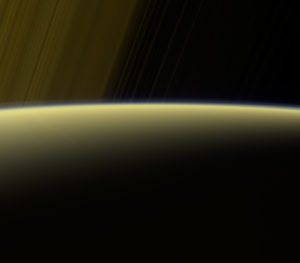 A hazy sunrise on Saturn with rings visible in the background
A hazy sunrise on Saturn with rings visible in the background A twenty-year odyssey to explore Saturn and its moons will come to end on September 15 when NASA’s Cassini probe will plunge into Saturn’s atmosphere and burn up. On Thursday, September 7, I attended a program about Cassini’s journey at the Library of Congress presented by space scientist Dr. Conor Nixon, a member of the Cassini mission team. Nixon, who works at the Planetary Systems Laboratory at NASA Goddard in Greenbelt, Maryland, helped build and test the Composite Infrared Spectrometer instrument onboard the probe. He was a graduate student when the Cassini probe was launched on October 15, 1997.
It took Cassini seven years to reach Saturn. In order to get into orbit around the the sixth planet from the sun, the probe had to sling shot around Venus twice and used Earth and Jupiter for additional gravity assists. It finally reached orbit on July 1, 2004. Nixon said the value of Cassini’s discoveries cannot be underestimated. Here are some of the amazing things we now know about Saturn and its moons thanks to this deep space obiter.
Saturn
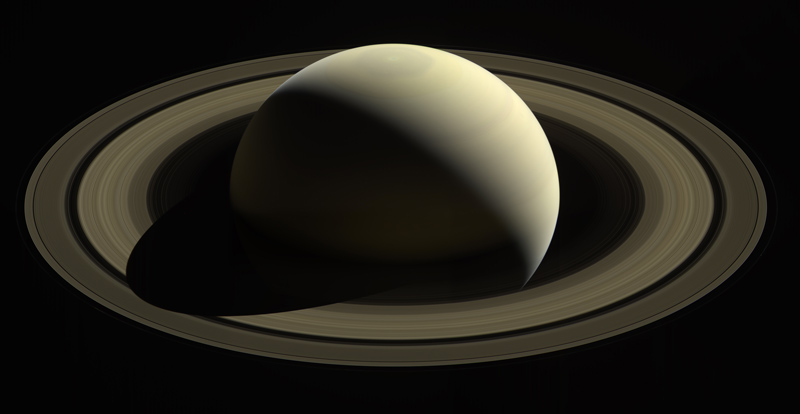
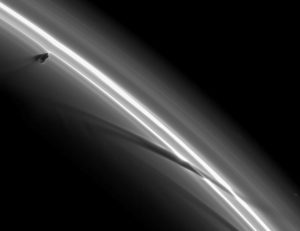
A moon disturbs Saturn’s rings
The second-largest planet in our solar system is most famous for its rings, which with a decent telescope can been seen by anyone from Earth. No one knows what caused Saturn’s rings, but Nixon said a leading theory is that millions of years ago two moons collided and their debris has been pushed and pulled by gravity to form the rings. The rings may be transient, Nixon warned, and disappear in 100 million years. Jupiter, Neptune, and Uranus have rings too, but theirs are thin and made up of only dirt and debris. Saturn’s rings are unique in that they are icy, allowing them to reflect the sun.
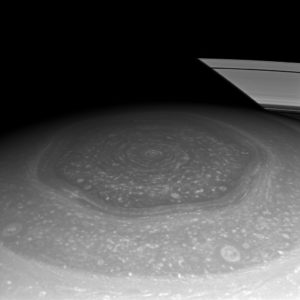
Saturn’s north polar hexagon
The rings are only a few hundred yards thick and show dark spaces where there appear to be gaps. These gaps are caused by moons orbiting amid the debris, pushing it out from their own orbits. The moons have a visible effect on the rings; Cassini’s images showed scalloping in one ring as a moon passed by.
One of the most spectacular discoveries that Cassini has shown us is the north pole of the planet, which has a gargantuan storm in the shape of a hexagon swirling around it. The storm is 1,250 miles wide (about the distance from New York City to Omaha, Nebraska) and the cloud speeds around the hurricane-like eyewall reach 330 mph. When Cassini first sent images back of the storm, it had a bluish tinge and a yellow center; today the eye is a bright blue and the storm is yellowish. Nixon attributed the color change to the effects of the sun.
Enceladus
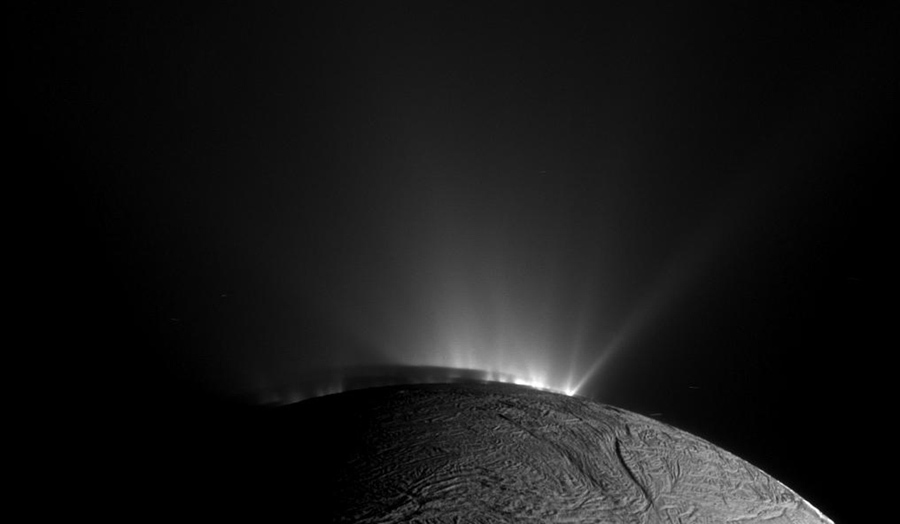
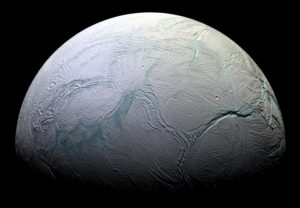 The sixth-largest moon of Saturn’s 63 satellites was named for a giant in Greek mythology. However, Enceladus is not that large at 310 miles in diameter. What make this ice moon noteworthy are the four large cracks in its surface that Cassini spied but which puzzled scientists. It wasn’t until Cassini got a view of the moon with the sun behind it that the cracks’ existence became clear when plumes of ice mist shooting hundreds of miles out into space became visible. The ice mist trails behind the moon as it orbits Saturn, creating its own tiny ring.
The sixth-largest moon of Saturn’s 63 satellites was named for a giant in Greek mythology. However, Enceladus is not that large at 310 miles in diameter. What make this ice moon noteworthy are the four large cracks in its surface that Cassini spied but which puzzled scientists. It wasn’t until Cassini got a view of the moon with the sun behind it that the cracks’ existence became clear when plumes of ice mist shooting hundreds of miles out into space became visible. The ice mist trails behind the moon as it orbits Saturn, creating its own tiny ring.
Scientists have since discovered older nonactive cracks on Enceladus’ surface. Nixon said that it is likely there is liquid water deep inside the moon and pressure pushes it out through these cracks in the frozen surface. Because of the geyserlike appearance of the ice mist plumes, the Cassini team affectionately calls the area “cold faithful.”
Titan
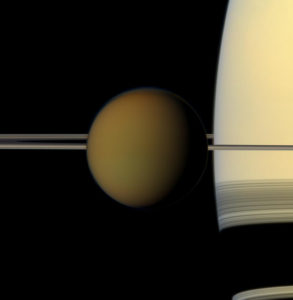 Saturn’s largest moon, Titan, is the only body in the solar system besides Earth to conclusively have surface liquids. Unfortunately, those lakes consist of methane and are often referred to as “gasoline” lakes by NASA. Titan appears orange in images and through telescopes because, Nixon explained, molecules of cyanides in the atmosphere cause the coloration. “You might smell almonds if you were able to breath in the air,” he said with a grin.
Saturn’s largest moon, Titan, is the only body in the solar system besides Earth to conclusively have surface liquids. Unfortunately, those lakes consist of methane and are often referred to as “gasoline” lakes by NASA. Titan appears orange in images and through telescopes because, Nixon explained, molecules of cyanides in the atmosphere cause the coloration. “You might smell almonds if you were able to breath in the air,” he said with a grin.
Scientists believe that under Titan’s ice shell lies a salty ocean—as salty as Earth’s Dead Sea. The ocean’s depth varies around the moon, suggesting that it is slowly freezing.
Other Moons
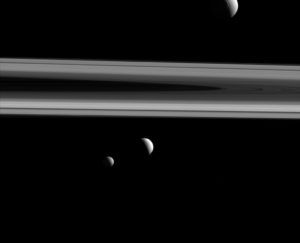
Three of Saturn’s moons: Tethys, Enceladus, and Mimas
George Lucas eat your heart out—Saturn’s moon Mimas is referred to by some as the Death Star for its eerily similar-looking crater and peak, called the Herschel Crater and Herschel Peak after the astronomer who discovered the moon in 1789. Cassini provided the first global images of the moon.
Atlas and Pan, first discovered by the satellite Voyager as it passed by in 1990, are shaped like “flying saucers or tortellini,” said Nixon. The tiny inner moons, at nine and twenty-two miles in diameter, respectively, were first seen up close by Cassini this past spring. They have a round middle and a thin ridge around their respective equators. None of Saturn’s other moons share this shape.
Grand Finale
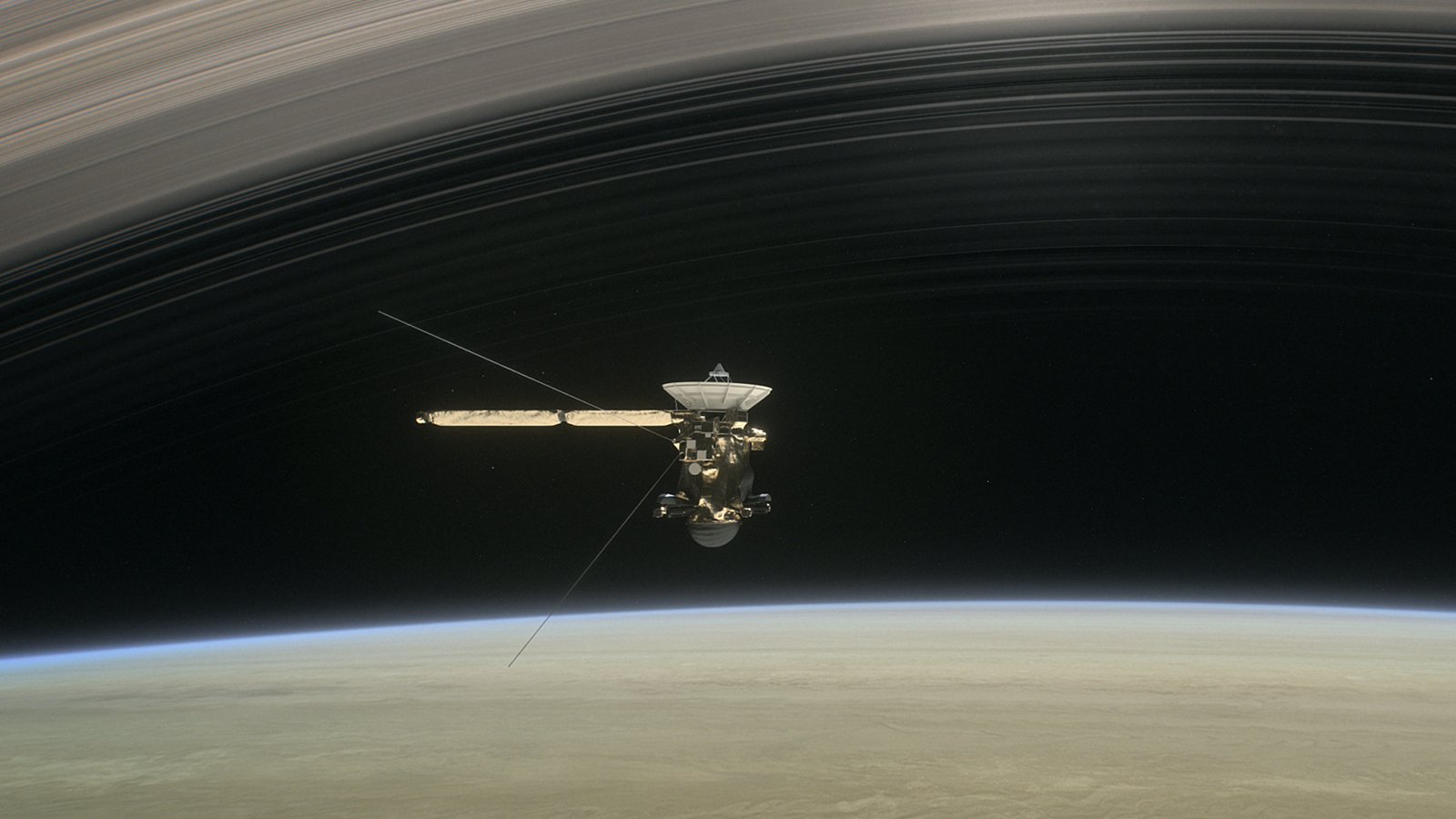
With less than 10 percent of its nuclear-sourced fuel left, Cassini was given a final mission that began in April. The probe has adjusted its orbits to fly closer and closer to Saturn’s rings and through the narrow space between the innermost rings and Saturn’s atmosphere. The orbits have allowed NASA to use a variety of instruments to collect data about Saturn’s atmosphere and the particles in the rings.
Nixon said that it takes approximately eighty-three minutes for a signal from Cassini to reach Earth. The probe will position its antenna toward Earth to allow a signal to continue as long as possible as it dives into the atmosphere. The last expected signal is expected to arrive on Friday at 8 a.m. EST. Nixon said the end will be bittersweet for the thousands of people who worked on the probe and its mission. But Cassini’s legacy is assured, and the data Cassini has collected will continue to be studied for years.
All photos by NASA/JPL-Caltech/Space Science Institute
